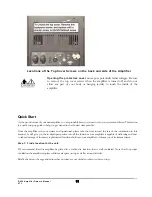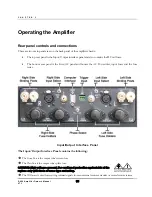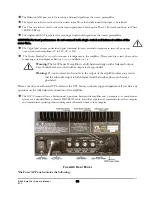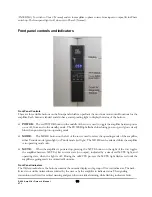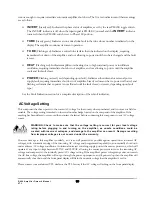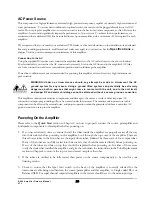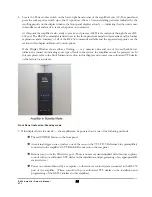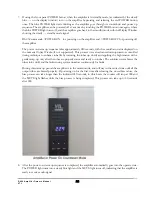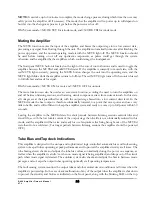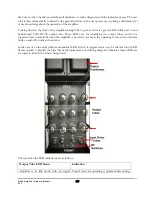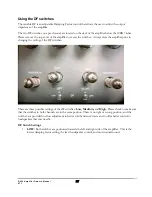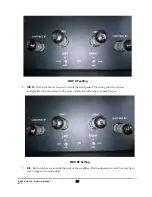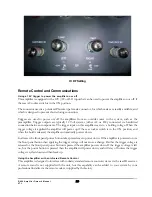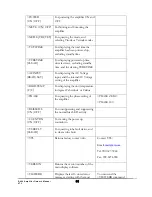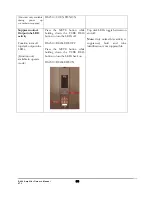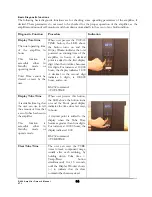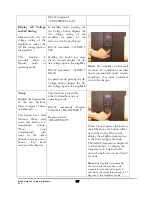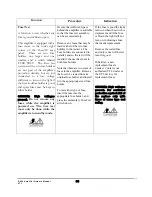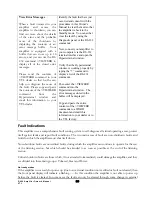
NOTE:
It can take up to 8 minutes to complete the mode change process, during which time the user may
safely power the amplifier off if necessary. The mode that the amplifier will re-power up in will depend on
how far into the changeover process it got before the power was shut off.
RS-232 commands: >MODE TET for tetrode mode, and >MODE TRI for triode mode.
Muting the Amplifier
The MUTE function mutes the input of the amplifier, and biases the output stage into a low current state,
preventing any signal from flowing through the unit. The amplifier automatically unmutes after finishing the
power up process, and the normal operating mode is with the MUTE light off. The MUTE function should
be used before turning on or off any upstream components, as pulses could get through the system
otherwise, and be amplified by the amplifiers, which could damage the loudspeakers.
The front panel MUTE button is located on the right of the row of control buttons and is used to toggle the
amplifier between the MUTEd and unMUTEd states. If the amplifier is currently in muted state, with the
red MUTE light on steady, pressing the MUTE button changes the unit into the operating state, and the
MUTE light blinks while the amplifier returns to full bias. The red MUTE light turns off when unit is biased
to full idle bias and ready for signal.
RS-232 commands: >MUTE ON for mute and >MUTE OFF for unmute.
The mute function can also be used as an ever-warm function, avoiding the need to turn the amplifiers on
and off between listening sessions, and lowering circuit component stress from current inrush. In this state
all voltages are at their prescribed levels, with the output stage biased into a low current draw level. In the
MUTEd mode the heat output is therefore substantially lowered, to a point that saves power and uses very
little tube life, and is still sufficient to keep the amplifier warm and ready to come up to full power within 30
seconds.
Leaving the amplifier in the MUTEd state for short periods between listening sessions extends tube and
circuit life, as with the low trickle current of the output stage the tube life is not substantially reduced in this
mode, and the amplifier will be warm and ready for use far quicker after being brought out of the MUTEd
state than from a cold start. (For longer periods between listening sessions the amplifier should be powered
OFF.)
Tube Bias and Top deck Indications
This amplifier is designed with a unique and sophisticated logic-controlled automatic bias and fault-sensing
system to keep all tubes operating at peak performance and to protect the amplifier circuitry at all times. The
tube biasing circuit checks and adjusts the tube bias values automatically during the power on sequence, as
well as when the amplifier is at idle (i.e. when no music signal is being amplified.) and drops out of the circuit
path when music signal is detected. The autobias system also checks and adjusts the bias in between music
passages, and so keeps the output tubes operating optimally at all operating temperatures.
The fault sensing system monitors the output tubes and other critical circuit conditions at all times when the
amplifier is powered up. In the case of any malfunction of any of the output tubes the amplifier is shut down
to protect the circuitry and faults are indicated on the front panel, along with the blinking LED on the top
S-400 Amplifier Owner’s Manual
VTL
24


